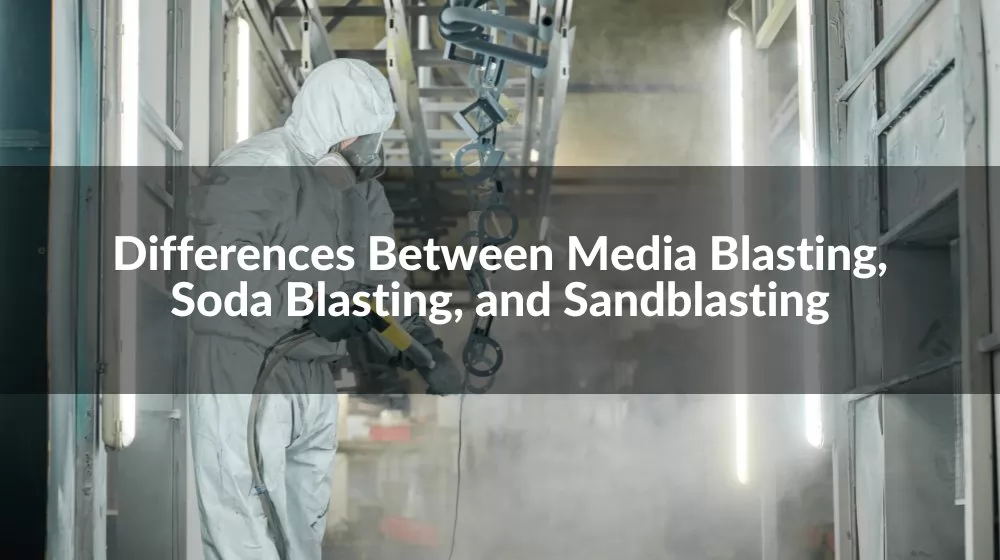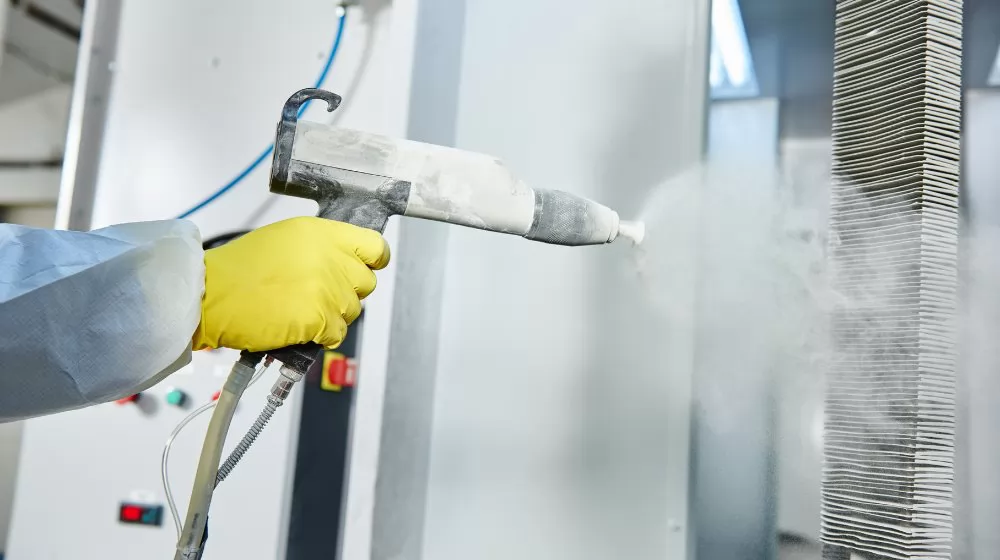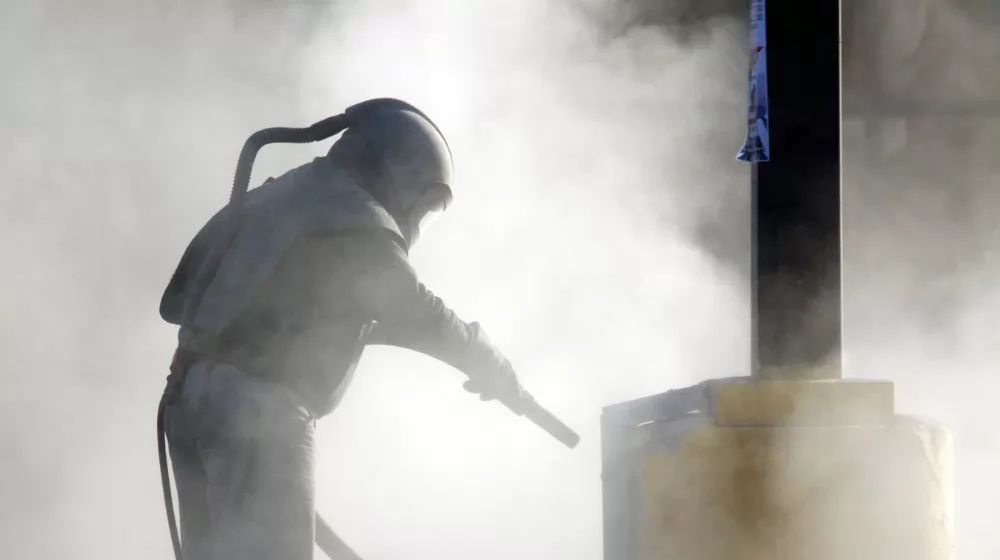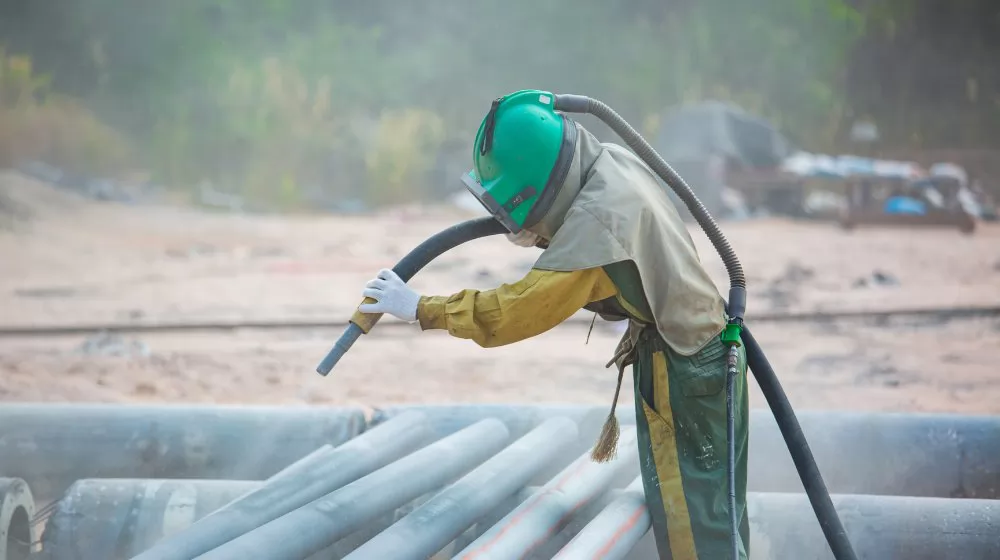
.png)

.png)
.png)


-
.png) 0086-757-85407388
0086-757-85407388 -

-
 terrychen@wintoly.com
terrychen@wintoly.com


.png)

.png)
.png)


.png)




When it comes to surface preparation and restoration, the methods you choose can make or break your project. Whether it's Media Blasting, Soda Blasting, or Sandblasting, each has its own set of unique benefits and challenges. In this complete guide, we'll dive deep into the nuances of these abrasive blasting techniques so you can make an informed decision for your next project.
Ah, abrasive blasting—you've probably heard this term thrown around, especially if you're in the manufacturing, restoration, or industrial sectors. But what does it really mean? Let's peel back the layers and get to the core of this intriguing subject.
Abrasive blasting, sometimes known as media blasting, is a process that involves propelling a stream of abrasive material against a surface. This is done under high pressure to smooth a rough surface, roughen a smooth surface, shape a surface, or remove surface contaminants. Whether you're thinking about media blasting, soda blasting, or sandblasting, they all come under the grand umbrella of abrasive blasting.
It's not just about getting rid of rust or prepping a car for a new coat of paint. Abrasive blasting has a wide range of applications, transcending multiple industries. So, where might you stumble upon this practice?
Impressive, right? From autos to art, abrasive blasting proves its mettle (and metal) across a myriad of sectors. It's safe to say that this technique is more ubiquitous than one might initially think.
Hold on to your hard hats, folks! We're diving deeper into the world of abrasive blasting by zoning in on a specific form—media blasting. Let's break down what it is, how it works, and why you might choose it over other types of blasting.
Media blasting is a subtype of abrasive blasting where various types of media are used to remove paint, rust, and other coatings from a particular surface. The process involves projecting this media at high speeds towards the surface in question, all done through a blasting nozzle. The power of the compressed air or water propels the media, making this a highly effective way to clean or prepare surfaces. Media blasting offers a lot of flexibility because you can switch out the media to suit different tasks. Intrigued? You should be!
So, you're keen on media blasting, but wondering what 'media' actually means in this context? Allow me to elaborate:
Choosing the right media is crucial, as it impacts the quality of your work. Sounds like something you'd be up for? Read on.
It's not just a one-trick pony; media blasting has its hooves in various industries. You'll often find it in:
So there you have it—a complete primer on media blasting! Whether you're in the construction game, tinkering with cars, or blasting off into space, media blasting has something to offer you.

Alright, so we've established that media blasting is pretty darn versatile. But as they say, every rose has its thorns. Let's get a full view of this technique by looking at its pros and cons.
First up, let's talk about why you might want to opt for media blasting in your next project.
One of the greatest benefits of media blasting is its adaptability. With a range of media to choose from, you can tailor your approach to the job at hand. Need a gentle touch? Opt for plastic beads. Looking for some heavy-duty action? Aluminum oxide has got you covered. Isn't it nice to have options?
When compared to other methods like grinding, media blasting typically generates less heat. This is a big deal, especially when working with materials that are sensitive to high temperatures. You get to maintain the integrity of the workpiece while still getting the job done. How cool is that?
Now, before you go all in, let's take a moment to consider some of the drawbacks of media blasting.
Let's be upfront—media blasting can be expensive. The costs of the media, machinery, and skilled labor can add up pretty quickly. If you're on a tight budget, you might need to think twice.
Don't forget about the aftermath. Disposing of used media can be a hassle, not to mention the environmental concerns. You'll need to make sure you're adhering to regulations and finding sustainable ways to manage waste. Feeling overwhelmed? You're not alone.
So, there you have it—the good, the bad, and the nitty-gritty of media blasting. Like any tool or technique, it's not a one-size-fits-all solution, but it's got a lot to offer to the right projects.
Hey there, blast enthusiasts! Buckle up, because we're shifting gears to another popular form of abrasive blasting—soda blasting. Trust me, it's not what you think. There's no actual soda involved, at least not the kind you drink! Ready to be enlightened? Let's dive in!
Soda blasting is a gentler form of abrasive blasting that utilizes sodium bicarbonate, commonly known as baking soda. The process is quite similar to media blasting, but instead of using various types of media, it specifically uses this eco-friendly, water-soluble material. A high-pressure system propels the soda particles onto the surface you're working with.
Why go for soda blasting? Good question! The appeal is its non-destructive nature, making it suitable for delicate surfaces. While other types of abrasive blasting can erode or warp the material, soda blasting allows you to maintain the original structure. Now, that's something to cheer about!
A typical soda blasting operation involves the following steps:
You might be wondering where this all comes into play. Let's get to that!
In essence, soda blasting is a versatile, eco-friendly, and delicate yet effective form of abrasive blasting. It fits like a glove in industries requiring a softer touch but still needing robust cleaning or paint removal capabilities.

By now, we know soda blasting is more than just a fizz—it's an effective, versatile blasting method. But hold your horses; it's not a panacea. So, how about we uncork this bottle and let the pros and cons flow out? Shall we?
First, let's toast to the things that make soda blasting a standout choice.
One of the standout features of soda blasting is its eco-friendliness. The key ingredient—baking soda—is biodegradable and non-toxic. If being environmentally responsible is on your agenda, then soda blasting ticks that box with flying colors. Plus, it's easier to dispose of used soda in compliance with environmental regulations. So, how's that for being green?
Got a delicate job? No worries. Soda blasting is like a gentle whisper compared to the scream of more abrasive methods. It's excellent for surface preservation, making it ideal for historical restorations, automobile refurbishing, and anywhere else you'd like to tread lightly. It allows you to remove contaminants without etching or warping the surface. So, why choose a sledgehammer when a feather will do?
Alright, time for some hard truths. Soda blasting is not without its drawbacks. Let's take a look.
While being gentle is a plus, it's also a downside. When it comes to robust, heavy-duty cleaning, soda blasting may not pack the punch you're looking for. If you've got layers of stubborn rust or industrial-grade grime, you might find yourself going over the same spot more times than you'd like. Is it worth the extra effort? Only you can decide.
Yes, soda is water-soluble, but that doesn't mean it always washes away clean. Residue can remain, and in some instances, this can interfere with subsequent processes like painting or coating. Plus, while baking soda is non-toxic, it's also alkaline, which could affect the pH levels of surrounding soil or water if not managed correctly. It's like enjoying a fizzy soda; delightful, but sometimes it leaves a sticky mess behind.
In summary, soda blasting can be a remarkable tool in your blasting arsenal. It's an environmentally-conscious choice and gentle on surfaces, but keep in mind its limitations. It's not the best fit for every job out there, but when it's the right tool for the task, it shines.
If soda blasting is the gentle whisper in the realm of abrasive blasting, then sandblasting is the shout that gets things done—no holds barred. Intrigued? Let's dig into the nitty-gritty details!
What is sandblasting, you ask? Imagine a high-speed force of abrasive particles, specifically sand, blasting against a surface. Yep, that's sandblasting in a nutshell. Typically, compressed air or a centrifugal wheel is used to propel the sand at high speeds. If you've got tough jobs that need heavy-duty cleaning, stripping, or surface preparation, then sandblasting is your go-to method. It's like using a bulldozer where a shovel won't suffice. Makes sense?
While it's called "sand"blasting, the term is a bit of a misnomer. Yes, you can use actual sand, but there are other types of abrasive media often used in sandblasting as well. For example:
Each has its own set of advantages, disadvantages, and best-use cases. So, the "sand" in sandblasting can be tailored to fit the job at hand. Handy, right?
Sandblasting isn't a one-trick pony; it has its hooves in a lot of pastures. From industrial settings to artistic endeavors, its versatility is something to admire. Here are a few places where you'll commonly find sandblasting at work:
It's hard to imagine a world without sandblasting, given how embedded it is in so many different fields. Whether you're looking to restore an old classic car or prepare a surface for industrial-grade painting, sandblasting has got you covered.
Everything comes with a price, right? Sandblasting is no exception. While it's excellent at what it does, it's crucial to weigh the good against the not-so-good. Stick with me as we delve into the pros and cons of this popular abrasive blasting technique.
Ever heard the phrase, "Time is money?" Well, sandblasting saves you both. Its highly efficient nature means fewer man-hours spent on labor, thereby cutting down costs. It's like going grocery shopping with a list—you're in and out before you know it, having spent money only on what you need. Who wouldn't want that, especially in a business setting?
Some jobs require the 'big guns,' and sandblasting brings them. Its high level of abrasiveness makes it ideal for removing layers of rust, paint, and other coatings that other methods might struggle with. Think of it like using a sledgehammer where a regular hammer won't do. The result? A pristine surface ready for further treatment or painting.
While sandblasting is mighty effective, it isn't always kind to the human body. Operators must be very cautious and use appropriate personal protective equipment. Inhalation of sand particles, for instance, can lead to silicosis, a serious lung disease. Safety protocols aren't a 'nice-to-have'; they're a must. It's like dealing with fireworks; thrilling but hazardous if you're not careful.
Imagine you've bought a brand new car, but accidentally scratched it while parking. The power of sandblasting can sometimes be a disadvantage—especially when dealing with delicate surfaces. Too much force can warp or etch the surface, potentially causing more harm than good. Like having too much of a good thing, moderation and expertise are key here.

Picture this: You're standing in front of two power tools, each promising to get the job done. One's a Swiss Army knife, and the other's a specialized carving tool. Which do you pick? The answer isn't so black-and-white, right? The same can be said about Media Blasting and Soda Blasting. Let's get into it.
When it comes to effectiveness, both Media and Soda Blasting have their high points. Media blasting is the Swiss Army knife here, adaptable to a wide array of situations. It can strip paint, remove rust, and even etch glass. Soda blasting, on the other hand, is your specialized carving tool. It's great at its job—like cleaning delicate surfaces—but lacks the broad effectiveness of media blasting. So, effectiveness really depends on what you're aiming to achieve. Does one size fit all, or are you looking for a custom fit?
Imagine you're cleaning a rare, antique painting. Would you use the same cloth that you'd use to clean your car? Probably not. The same principle applies here. Soda blasting is gentler and less abrasive, making it the go-to for delicate tasks like graffiti removal from historic buildings or cleaning engine parts without causing damage. Media blasting, while versatile, can be too harsh for such specialized tasks. It's like comparing a scalpel to a butcher's knife. Each has its purpose, but you wouldn't use them interchangeably.
Money talks, right? Well, in the world of blasting, your budget might just dictate your choice. Media blasting tends to be more cost-effective, especially for larger, more demanding jobs. Soda blasting media can be more expensive and less reusable. But remember, cheaper doesn't always mean better. If you're working on a project that requires a delicate touch, the additional cost of soda blasting may be a small price to pay for preserving the integrity of the surface. It's like choosing between a fast-food burger and a gourmet meal—each has its value depending on the situation.
You wouldn't use a chainsaw to cut a birthday cake, would you? Similarly, choosing between Media Blasting and Sandblasting involves considering the 'fit' for the task at hand. Is it a heavy-duty operation or something more nuanced? Let's dive in and dissect the differences.
Both Media Blasting and Sandblasting aim to remove layers from surfaces, but they're not twins; they're more like cousins. Media Blasting is the more adaptable family member, allowing you to switch between different types of blasting media—like glass beads, plastic, or even walnut shells. This adaptability allows for a range of abrasiveness levels. Sandblasting, by contrast, is the muscle in the family. Its abrasiveness is high, which makes it fantastic for tasks like stripping rust off industrial machinery but not so great for your vintage wooden furniture. So, who wins the abrasiveness contest? Sandblasting—but remember, higher abrasiveness isn't always better.
When it comes to tasks that require serious muscle, like removing multiple layers of paint or decades of corrosion, Sandblasting steals the spotlight. It's like hiring a powerlifter to help you move houses; you wouldn't expect anything less than high performance. Media Blasting can handle heavy-duty tasks too, but you'll need to carefully select the appropriate media. The choice here is like deciding between an all-terrain vehicle and a sports car; both can be fast, but one is clearly better suited for rough terrains.
We all want to be good stewards of the Earth, right? Well, in the environmental derby, Media Blasting has a slight edge. Because you can choose from a variety of materials, it's easier to pick environmentally friendly options like biodegradable plastic or recycled glass beads. Sandblasting, however, generally uses silica sand, which can be an environmental concern if not disposed of properly. Think of it like choosing between disposable plastic plates and reusable ones; the latter is clearly the greener choice.
Think of Soda Blasting and Sandblasting like Batman and Superman—both superheroes, but with different skills, weaknesses, and fans swearing they're the best. Let's see who wins in what arena, shall we?
Mother Nature might just have a favorite between the two, and that's Soda Blasting. Why? Because its main ingredient—baking soda—is biodegradable and less harmful to the environment. Sandblasting, often using silica sand, can pose environmental risks if not managed properly. Imagine having to choose between a hybrid car and a gas guzzler for a road trip; which one would you feel better about?
When it comes to tasks requiring finesse and detail, Soda Blasting shines brighter. It's your precision instrument, the scalpel to Sandblasting's broadsword. Because it's less abrasive, Soda Blasting is superb for cleaning intricate machinery parts or restoring antiques without damaging the surface. Sandblasting, while effective, can be too much of a blunt instrument for these kinds of tasks. It's like using a fire hose to water your garden—not the best idea, right?
Nobody likes the cleanup, but it's a necessary evil. Here's where Sandblasting might have a slight advantage. The sand used in Sandblasting is often easier to sweep up compared to the soda residue, which can be somewhat filmy and may require additional cleaning steps. Think of it like cleaning up after a kid's birthday party versus a cocktail party. One's going to require a little more elbow grease.
Okay, you've done your homework, you've read up on Media Blasting, Soda Blasting, and Sandblasting. But how do you decide which is the right one for your specific project? It's like choosing between an electric car, a gas car, and a hybrid—each has its own merits depending on your needs. Let's break it down.
Just like you wouldn't buy a pair of shoes without considering their fit, style, and occasion, you shouldn't pick a blasting method without a little bit of introspection. Look at factors such as the material you'll be working on, the level of precision required, and your budget.
Is your surface delicate or robust? For instance, metal surfaces can typically withstand the high abrasiveness of Sandblasting, whereas Soda Blasting would be better for more sensitive surfaces like wood or fiberglass. So, are we talking about an elephant's hide or a butterfly's wing here?
If your project involves detailed work—think intricate machinery or antique restoration—precision is key. In such cases, Soda Blasting with its gentle touch is your best buddy. It's like using a laser pointer instead of a flashlight to focus on something specific.
Let's talk money. Sandblasting is generally more cost-effective than other methods, but remember, the initial cost isn't the only factor. You should also consider the potential costs of cleanup and waste disposal. Think of it like buying a printer; the initial cost might be low, but what about the ink cartridges?
Last but not least, your choice of manufacturer can make or break your project. Look for manufacturers who not only offer high-quality equipment but also comprehensive customer support. It's like marrying into a family; you're not just getting a spouse, you're getting their whole clan, so choose wisely.

So, you're convinced that blasting is the way to go for your project, but you're watching your budget like a hawk. Fear not; we're here to give you a clear picture of what you can expect to shell out. It's like going grocery shopping with a list—you're less likely to end up with a cart full of impulse buys.
Let's start with the stuff that makes the magic happen—the blasting media. Sand is generally cheaper than soda. Think of it like comparing store-brand cereal to the name-brand stuff; they'll both fill you up, but one is definitely lighter on your wallet. Media Blasting offers a range, with some options like glass beads being pricier than others.
Now, the people doing the work also need to get paid. Labor costs can vary, but generally, Soda Blasting and Media Blasting require more skill and hence can be more labor-intensive. It's like choosing between hiring a seasoned chef or a fast-food cook; expertise comes at a price.
Finally, let's talk equipment. Here, your costs can range significantly depending on whether you opt for a basic setup or a more advanced one. Media Blasting equipment tends to be more versatile but can be pricier. It's like the difference between a smartphone and a flip phone; one does a lot more but comes with a heftier price tag.
Sure, we've given you a lot of information, but how does all this theory play out in the real world? Let's look at some case studies that illustrate the effectiveness of Media Blasting, Soda Blasting, and Sandblasting in various applications. It's like seeing a recipe and then actually tasting the dish!
Media Blasting is often the go-to method for automotive restoration. Imagine taking an old, rust-ridden car and transforming it into a shiny, like-new vehicle. Media blasting is versatile enough to remove rust without damaging the underlying metal. It's like giving a 100-year-old painting a careful restoration, bringing the masterpiece back to its former glory.
When it comes to removing graffiti, especially from sensitive surfaces like historical buildings, Soda Blasting is the star. It not only gets rid of the graffiti but does so without harming the original surface. Think of it as gently wiping away a child's crayon marks from a precious photo. The memories (or, in this case, the wall's original features) remain intact.
In the construction industry, Sandblasting is the heavy lifter for tasks like removing layers of paint, dirt, or old coatings from large structures. This is your rugged, robust solution when you need the big guns. Imagine it as using a snowplow to clear a parking lot after a blizzard; you want the raw power to get the job done.
So, now that you're well-versed in the ins and outs of Media Blasting, Soda Blasting, and Sandblasting, why not take your project to the next level? With powder coating, you can achieve a long-lasting, durable finish that's also environmentally friendly. If you're looking for a trusted powder coating manufacturer or a custom powder coating solution, look no further than Wintoly.
Our experts at Wintoly provide top-notch powder coating services that meet and exceed industry standards. From automotive parts to intricate industrial components, we've got you covered. Visit our website www.wintoly-coatings.com for more information on how we can make your next project a smashing success. It's time to add that extra polish to your work!
Read More:

 terrychen@wintoly.com
terrychen@wintoly.com
.png) 0086-757-85407388
0086-757-85407388
 6 Chaoyang Rd., National Demonstration Eco-industrialzone, Nanhai, Foshan,Guangdong,China
6 Chaoyang Rd., National Demonstration Eco-industrialzone, Nanhai, Foshan,Guangdong,China

.png)
